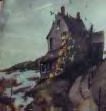- California Gull
Taxobox
name = California Gull
status = LC | status_system = IUCN3.1

image_width = 240px
image_caption = California Gulls on a rooftop on Antelope Island, Utah
regnum =Animal ia
phylum = Chordata
classis = Aves
ordo =Charadriiformes
familia =Laridae
genus = "Larus "
species = "L. californicus"
binomial = "Larus californicus"
binomial_authority = (Lawrence,1854 ,Stockton, California )
subdivision_ranks =Subspecies
subdivision =
* "L. c. californicus" Taxobox_authority | author = Lawrence | date = 1854 Great Basin California Gull
* "L. c. albertaensis" Taxobox_authority | author = Jehl | date = 1987 Great Plains Galifornia GullThe California Gull "Larus californicus" is a medium-sized
gull , smaller than theHerring Gull but larger than theRing-billed Gull .Adults are similar in appearance to the Herring Gull, but have a smaller yellow bill with a black ring, yellow legs, brown eyes and a more rounded head. The body is mainly white with grey back and upper wings. They have black primaries with white tips. Immature birds are also similar in appearance to immature Herring Gulls, with browner plumage than immature Ring-billed Gulls.
Their breeding habitat is lakes and
marsh es in interior westernNorth America fromNorthwest Territories ,Canada south to easternCalifornia andColorado (Sibley 2000). They nest in colonies, sometimes with other birds. The nest is a shallow depression on the ground lined with vegetation and feathers. The female usually lays 2 or 3 eggs. Both parents feed the young birds.They are migratory, most moving to the
Pacific coast in winter. It is only then that this bird is regularly found in western California (Sibley 2000).These birds forage in flight or pick up objects while swimming, walking or wading. They mainly eat insects, fish and eggs. They also scavenge at garbage dumps or docks. They may follow plows in fields for insects stirred up by this activity.
This is the state bird of
Utah , remembered for assistingMormon settlers in dealing with a plague ofMormon cricket s. A [gull Monument] in Salt Lake City commemorates this event, known as the "Miracle of the Gulls ".There are two subspecies recognized, the nominate from the
Great Basin to centralMontana andWyoming , and the slightly larger, paler "L. c. albertaensis" with a more northerly distribution, ranging fromGreat Slave Lake onto theGreat Plains of westernManitoba andSouth Dakota (Jehl, 1987). Although these subspecies are not well distinguishable bymtDNA allozyme variation (Karl "et al.", 1987), they breed true and the low genetic divergence can be explained by separation during thePleistocene and renewed contact in Montana during more recent times (Jehl "et al.", 1990).In California, the California Gull recently held the protected status
California Species of Special Concern due to declining numbers at their historic California breeding colony atMono Lake . However, in recent decades this species has begun to breed in the southern portion ofSan Francisco Bay , where it did not historically breed, and has undergone exponential population growth. These California Gulls now inhabit large, remote salt-production ponds and levees and have a very large food source provided by nearby landfills from San Francisco, San Jose and other urban areas, all the way up into the Sacramento area. The South Bay California Gull population has grown from less than 1,000 breeding birds in 1982 to over 33,000 in 2006. This population boom has resulted in large resident flocks of gulls that will opportunistically prey on other species, particularly the eggs and nestlings of other birds. Seriously threatened birds that share the same South Bay habitat include theSnowy Plover andCalifornia Least Tern , while less-threatened birds includingBlack-necked Stilt s,American Avocet s,Forster's Tern s, andCaspian Tern s are also preyed upon by the abnormally large flocks of California Gulls. Efforts are underway to reduce habitat for this species and find other ways to disperse the large numbers of gulls. (Ackerman "et al". 2006)References
* Database entry includes justification for why this species is of least concern
*Ackerman, J. T., J. Y. Takekawa, C. Strong, N. Athearn, and A. Rex. 2006. California Gull distribution, abundance, and predation on waterbird eggs and chicks in South San Francisco Bay. Final Report, U. S. Geological Survey, Western Ecological and Research Center, Davis and Vallejo, CA. 61pp.
* Burger, Joanna & Gochfeld, Michael (1996): 13. California Gull. "In:" del Hoyo, Josep; Elliott, Andrew & Sargatal, Jordi (editors): "
Handbook of Birds of the World , Volume 3: Hoatzin to Auks": 604-605, plate 50. Lynx Edicions, Barcelona. ISBN 84-87334-20-2* Harrison, Peter (1991): "Seabirds: An Identification Guide". Houghton Mifflin.
* Jehl, Joseph R. Jr. (1987): Geographic variation and evolution in the California Gull ("Larus californicus"). "Auk" 104(3): 421–428. [http://elibrary.unm.edu/sora/Auk/v104n03/p0421-p0428.pdf PDF fulltext]
* Jehl, Joseph R. Jr.; Francine, J; Bond, S. I. (1990): Growth patterns of two races of California Gulls raised in a common environment. "
Condor " 92(3): 732–738. [http://elibrary.unm.edu/sora/Condor/files/issues/v092n03/p0732-p0738.pdf PDF fulltext]* Karl, S. A.; Zink, R. M.; Jehl, Joseph R. Jr. (1987): Allozyme analysis of the California Gull ("Larus californicus"). "Auk" 104(4): 767–769. [http://elibrary.unm.edu/sora/Auk/v104n04/p0767-p0769.pdf PDF fulltext]
*
National Geographic Society (2002): "Field Guide to the Birds of North America". National Geographic, Washington DC. ISBN 0-7922-6877-6* Sibley, David Allen (2000): "The Sibley Guide to Birds". Alfred A. Knopf, New York. ISBN 0-679-45122-6
* Winkler, D. W. (1996): California Gull ("Larus californicus"). "In:" Poole, A. & Gill, F.: "The Birds of North America" 259. The Academy of Natural Sciences, Philadelphia, PA & The American Ornithologists' Union, Washington, D.C.
External links
* [http://www.mbr-pwrc.usgs.gov/Infocenter/i0530id.html Patuxent Bird Identification InfoCenter] : California gull information and pictures. Retrieved
2006-09-27
* [http://www.birds.cornell.edu/AllAboutBirds/BirdGuide/California_Gull.html California Gull Species Account] - Cornell Lab of Ornithology
* [http://www.sdakotabirds.com/species/california_gull_info.htm California Gull Information and Photos] - South Dakota Birds and Birding
* [http://animaldiversity.ummz.umich.edu/site/accounts/information/Larus_californicus.html California Gull] at "Animal Diversity Web"
Wikimedia Foundation. 2010.
